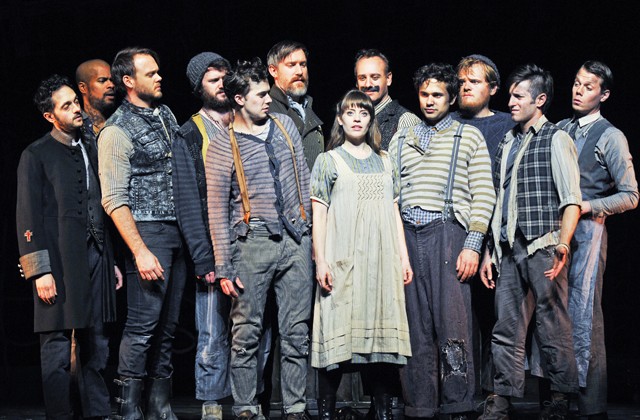Peter and the Starcatcher is delightfully absurd

You might think you know the story of Peter Pan, but the stage production of ‘Peter and the Starcatcher’ shows us how Peter and Captain Hook came to be.
Most people these days, I imagine, are familiar with Peter Pan in some form. Peter first made an appearance in a section of The Little White Bird, a 1902 novel for adults written by J.M. Barrie. Peter then took to the stage in 1904 as the star of his own show, and the play was adapted into a novel which was published in 1911.
Peter Pan has lived on in countless stage, movie and television productions, most notably the stage/TV version starring Mary Martin and the classic Disney animated movie. The musical is still touring today with Cathy Rigby starring as “the boy who wouldn’t grow up.” But where did Peter Pan come from? How did he meet Captain Hook and Wendy Darling?
Those were the questions posed by writer Ridley Pearson’s daughter one morning, so he and Dave Barry came up with their version of Peter Pan’s origin story with the novel Peter and the Starcatchers (which went on to become a five-book series). The book proved to be popular enough for Disney to take an interest, but instead of going the CG animation route their theatrical division came on board and developed the story for the Broadway stage (and dropped the plural of the title along the way).
Peter and the Starcatcher opened Off-Broadway in 2011, transferred to Broadway on April 15, 2012 (closing January 20, 2013) and played again Off-Broadway from March 2013 – January 2014. And now Peter and the Starcatcher is touring the country, delighting audiences with its clever blend of slapstick, vaudeville, absurdity and heart.
The story is basically a prequel to Barrie’s Peter and Wendy, taking us back to a time in the 1860s where a group of boys in an orphanage are sold to a shady sea captain and are basically held as prisoners on the Neverland. There are actually two ships and two identical trunks, one of which is holding some mysterious treasure, and the other is a decoy. The decoy is supposed to be loaded onto the Neverland, but the ship’s “captain” turns out to be one of a band of pirates who swaps the decoy with the real treasure. It is also revealed that the true captain is the pirate Black Stache, so named because of his Groucho Marx-ish facial hair.
We also meet Molly and her father who are charged with transporting and protecting the precious cargo. Molly befriends the boys, Ted, Prentiss and Boy (he’s been an orphan so long he’s forgotten his name), and their voyage becomes an adventure that becomes a mission to save the world once it’s revealed that the cargo is something called “starstuff,” a magical element that can allow anyone to become whatever it is they dream to be. After the Neverland is shipwrecked, Boy and his friends become the cargo’s protectors until Molly, her father, the pirates and the natives get into the act (and Boy does finally get a name … yes, THAT name).
Peter and the Starcatcher is probably one of the most surprising stage productions I’ve seen this season. I was really expecting a musical, but it’s not. There are two songs, one closes the first act and the other opens the second, done in a true vaudeville style (and you must be in your seat so you don’t miss the second act opener). The story itself is told by a small cast of characters playing multiple roles, although they never really change costumes (although Boy somehow ends up in Act 2 with more clothes on than he had at the end of Act 1), and there is only a single set for each act (a ship interior and an island).
You may think that a single set limits the scope of the storytelling, but the staging and use of props to convey different areas of the ship are extremely creative, using everything from a rope to denote rooms and stairways, to the actors becoming walls and doors. On the island, a string of flags is used to represent a crocodile’s teeth, and mermaids are decked out in what can only be assumed is trash found floating at sea. These use of props and the creative lighting design make Peter and the Starcatcher unlike anything you’ve seen before.
The cast is also magnificent, and while they all play multiple roles, their main characters are impressively brought to life. Joey deBettencourt is very sympathetic as Boy, at first, and he makes you root for him to become the leader of his little group of friends, happy for him when he’s given a name, and then he breaks your heart when he realizes Molly and her dad are going to leave him and his friends on the island at the end, telling them how adults always lie and then they leave.
Luke Smith’s Smee is also a comic standout, and Megan Stern is a plucky Molly. She reminded me a lot of Anna Friel of Pushing Daisies. Benjamin Schrader is also very funny as Mrs. Bumbrake, Molly’s Nana. The show’s scene stealer, however, is John Sanders as Black Stashe. Sanders milks every bit of comedy he can from his role, getting the best lines and giving the best reactions to the activity surrounding him. He also gets the shows biggest laugh in what has come to be known as the “Hand Aria.” Sanders also gets a huge laugh when he’s told the giant crocodile is chewing up all of the scenery, and Stashe runs back to center stage and over-dramatically says, “Not in MY scene.” While everyone in the show is great, Sanders is the show’s MVP in the showiest role.
By the end of the show, I had a little tear in my eye (and Sanders, again, injects a comedic moment before things get too sappy) but left the theatre feeling happy and uplifted by the production. I’m not sure the videos I’ve seen online can properly sell the show, and it’s really hard to pigeon-hole the show into a single category. It’s drama, comedy, musical … I think it comes closest to the traditional holiday Pantomimes (or Pantos) that take a traditional story or fairy tale and add some slapstick, over-the-top comedy and pop culture references. Peter and the Starcatcher does all of that, referencing everything from Michael Jackson to cell phones. The modern references help audiences connect to the story, but they never really take you too far out of it either.
Peter and the Starcatcher is ultimately a magical show that tells a story without relying on a lot of fancy stage magic that rewards audiences with a lot of laughter and a very big heart. It’s whimsical, delightful, subversive, and hilarious … and I loved every minute. Peter and the Starcatcher is now playing at Baltimore’s Hippodrome Theatre through May 18, and will run in Pittsburgh at Heinz Hall May 20-25.
 CliqueClack
CliqueClack